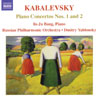Kabalevsky Piano Concertos Nos 1 and 2
A decent stop-gap version of Concerto No 1; No 2, though, is eclipsed by others
View record and artist detailsRecord and Artist Details
Composer or Director: Dmitry Borisovich Kabalevsky
Genre:
Orchestral
Label: Naxos
Magazine Review Date: 7/2006
Media Format: CD or Download
Media Runtime: 56
Mastering:
Stereo
DDD
Catalogue Number: 8 557683

Tracks:
| Composition | Artist Credit |
|---|---|
| Concerto for Piano and Orchestra No. 1 |
Dmitry Borisovich Kabalevsky, Composer
Dmitry Borisovich Kabalevsky, Composer Dmitry Yablonsky, Conductor In-Ju Bang, Piano Russian Philharmonic Orchestra |
| Concerto for Piano and Orchestra No. 2 |
Dmitry Borisovich Kabalevsky, Composer
Dmitry Borisovich Kabalevsky, Composer Dmitry Yablonsky, Conductor In-Ju Bang, Piano Russian Philharmonic Orchestra |
Author: David Fanning
Unsurprisingly for a student piece, the first of Kabalevsky’s three piano concertos is a talented blend of Rachmaninov and Prokofiev, with a few echoes of Scriabin on the way. But there is something else there, too, something less characteristic of the mature composer and rather more intriguing – a tone of heavy-hearted reflectiveness. That surfaces especially in the slow movement, with more than a few harmonic shades borrowed from Kabalevsky’s teacher, Myaskovsky. Though the piece is hardly a viable candidate for full repertoire status it certainly deserves a place on the library shelves. There is no current rival recording and the accomplished 14-year-old Korean In-Ju Bang’s enjoyable playing offers a decent stop-gap.
With the Second Concerto, composed seven years later in 1935, Kabalevsky found his niche. The structure is tighter, the textures leaner and the ideas more catchy. Prokofiev is again a role-model, though Kabalevsky seems also to have picked up some tips from Shostakovich’s First Concerto (the debt was repaid when Shostakovich raided Kabalevsky’s first-movement cadenza for the opening idea of his Second Piano Sonata).
Against competition from Kathryn Stott in the Second Concerto, the Korean’s limitations are rather more evident, mainly in terms of authority of touch and range of characterisation. Nor is the Russian Philharmonic any match for the colouristic flair of the BBC Philharmonic, any more than Naxos’s respectable recording is for the brightness and clarity on offer from Chandos. Still, the new disc is perfectly recommendable at its bargain price.
With the Second Concerto, composed seven years later in 1935, Kabalevsky found his niche. The structure is tighter, the textures leaner and the ideas more catchy. Prokofiev is again a role-model, though Kabalevsky seems also to have picked up some tips from Shostakovich’s First Concerto (the debt was repaid when Shostakovich raided Kabalevsky’s first-movement cadenza for the opening idea of his Second Piano Sonata).
Against competition from Kathryn Stott in the Second Concerto, the Korean’s limitations are rather more evident, mainly in terms of authority of touch and range of characterisation. Nor is the Russian Philharmonic any match for the colouristic flair of the BBC Philharmonic, any more than Naxos’s respectable recording is for the brightness and clarity on offer from Chandos. Still, the new disc is perfectly recommendable at its bargain price.
Discover the world's largest classical music catalogue with Presto Music.

Gramophone Digital Club
- Digital Edition
- Digital Archive
- Reviews Database
- Full website access
From £8.75 / month
Subscribe
Gramophone Full Club
- Print Edition
- Digital Edition
- Digital Archive
- Reviews Database
- Full website access
From £11.00 / month
Subscribe
If you are a library, university or other organisation that would be interested in an institutional subscription to Gramophone please click here for further information.




